Table of Contents |
Our subject company, Legacy Clothing, is a sole proprietorship, which is a type of company that is owned by a single individual, and where that individual and the business are legally treated as the same.
The purpose of Legacy Clothing as a business is to own and operate clothing/merchandise stores. It is similar to a department store chain, selling men's, women's, and children's clothing and other related items.
Legacy Clothing has locations throughout Washington, DC, and they have a staff of 50 people employed in their stores.
| Legacy Clothing | |
|---|---|
| Type of company | Sole proprietorship |
| Business purpose | Own and operate clothing/merchandise stores |
| Business location(s) |
Washington, D.C. Staff of 50 people |
To evaluate the financial health of the business, Legacy clothing will perform several types of financial analyses. The first analysis Legacy will carry out is called a vertical analysis. A vertical analysis uses the income statement accounts and highlights the relationship between the individual accounts and overall revenue (net sales). A balance sheet vertical analysis compares all accounts to the total assets account.
Another way Legacy will analyze their financial statements is by conducing horizontal analyses. A horizontal analysis shows how different accounts have changed over time. Horizontal analyses will be performed on both the income statement and the balance sheet and are calculated by subtracting the least current year from the most current year then diving by the least current year. The result shows the percentage increase or decrease in an individual account.
Finally, several ratio analyses will be performed. Ratio analyses are performed to inform a business of its operating efficiency or how its business is performing in the sector.
Essentially, all three of these types of financial analysis are needed in order for Legacy Clothing to truly understand the state of their business, how it's performing and changing.
Using financial analysis, Legacy Clothing can do a comparison of changes within the company, as well as compare itself to other companies and against industry standards. In this manner, they have a better picture of their business and where they fit within the greater context of the competitive and industry landscape.
In today's lesson, we're going to look at our case study company in performing financial analysis, exploring examples of performing vertical analysis, horizontal analysis, and ratio analysis.
The first analysis Legacy Clothing will perform is a vertical analysis of its income statement.
The income statements from both 2021 and 2022 are provided. Our base amount for the vertical analysis is net sales. We will determine the relationships of all of the income statement accounts to net sales. These relationships will give us the percentage of sales each item accounts for, which we can use to understand the impact of the income statement accounts.
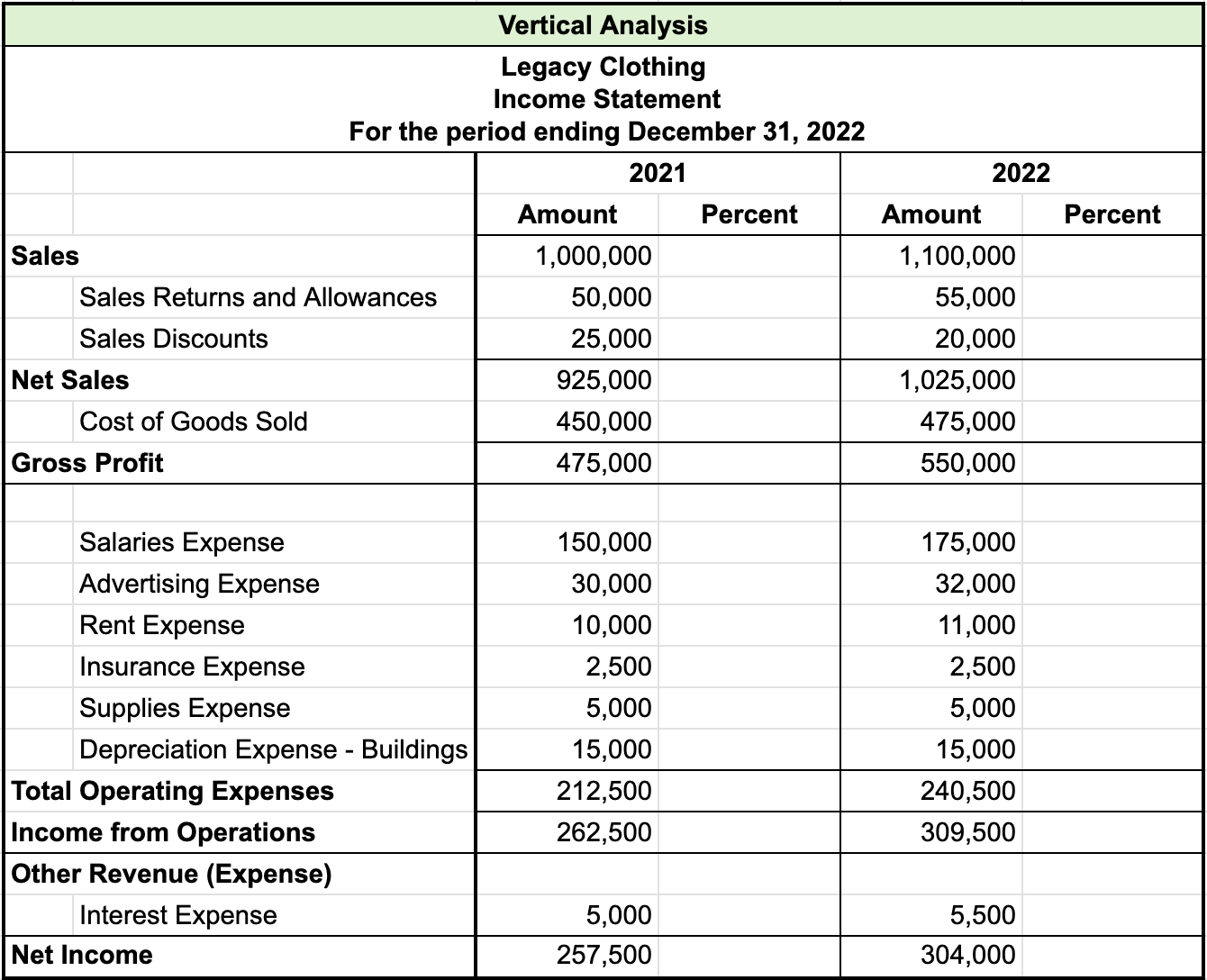
Next, we take the dollar figures on our income statement and convert them to a percentage of our base amount, for both years. In this manner, we can understand how these individual financial statement line items relate to our base amount, net sales.
For Legacy Clothing, salary expense was 16.2% of net sales in 2021, but in the following year, salary expense represented 17.1% of net sales. This allows us to see its changing composition over time.
Another example is sales, where 2021 sales represented 108.1% of net income while in 2022, sales decreased to 107.3% of net income.
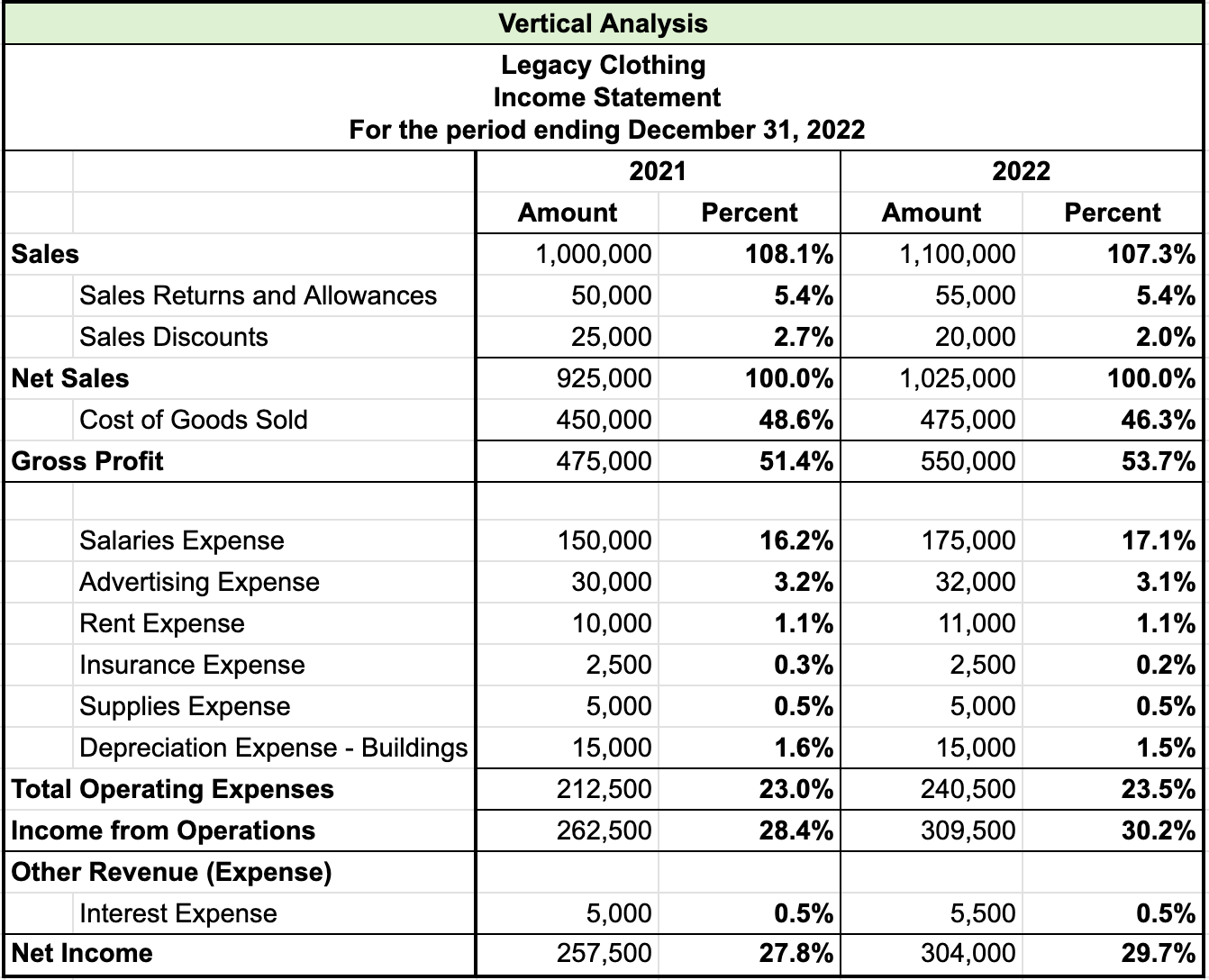
Now we can perform our vertical analysis for Legacy Clothing's balance sheet, performing the same type of exercise as we did with the income statement.
Once again, we're going to express these individual accounts, or financial statement line items, as a percentage of a base amount. In the case of the balance sheet, the base amount is our total assets.
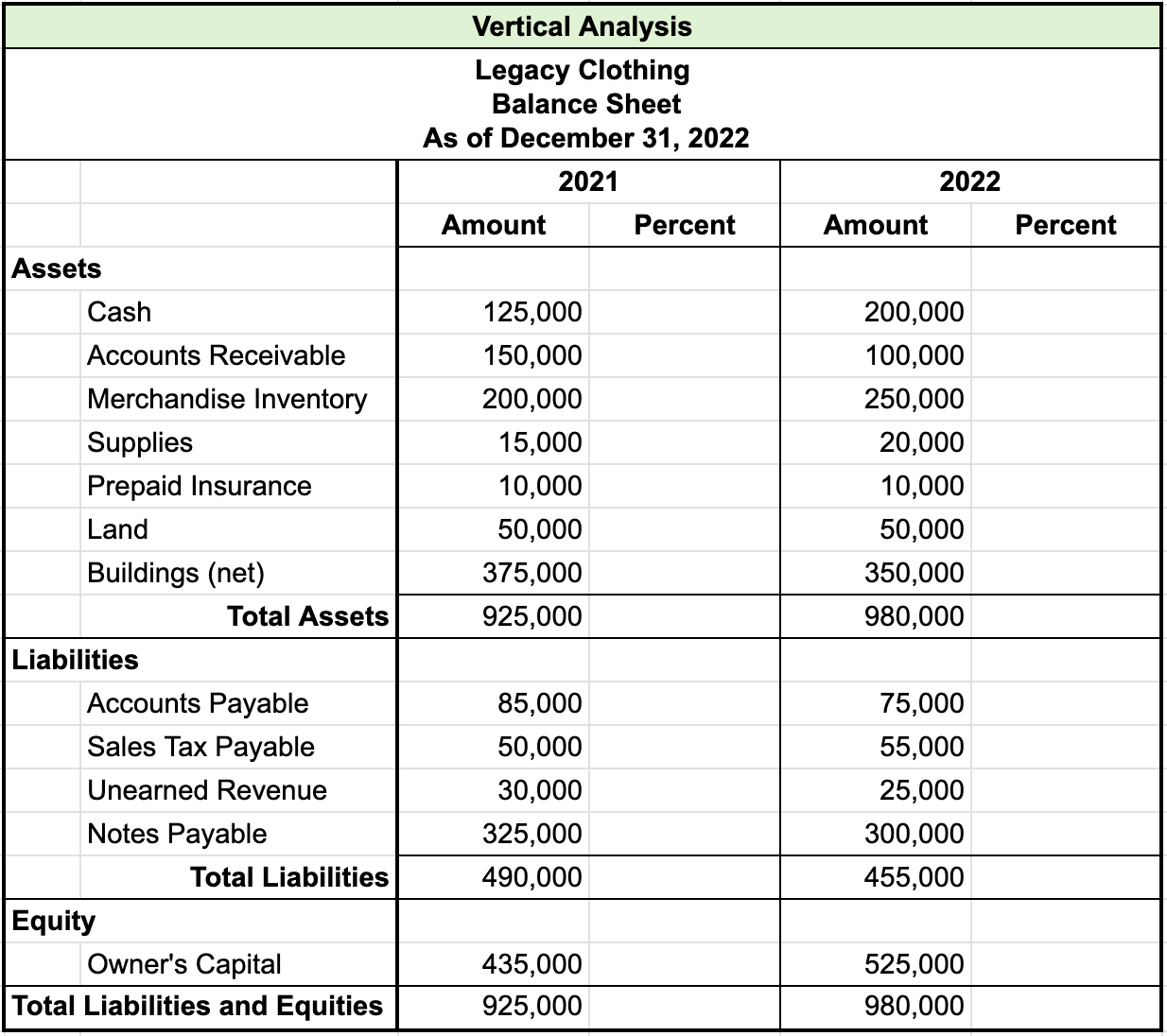
We express each line item as a percentage of that base amount. Note that total assets is 100%.
By expressing each line item as a percentage of the base amount, we can understand the composition of these line items, as well as any changes over time.
For example, in 2021, our merchandise inventory represented 21.6% of total assets, whereas in 2022, it represented 25.5%. In another instance, notes payable represented 35.1% of total assets in 2021 and 30.6% in 2022; therefore, notes payble is decreasing.
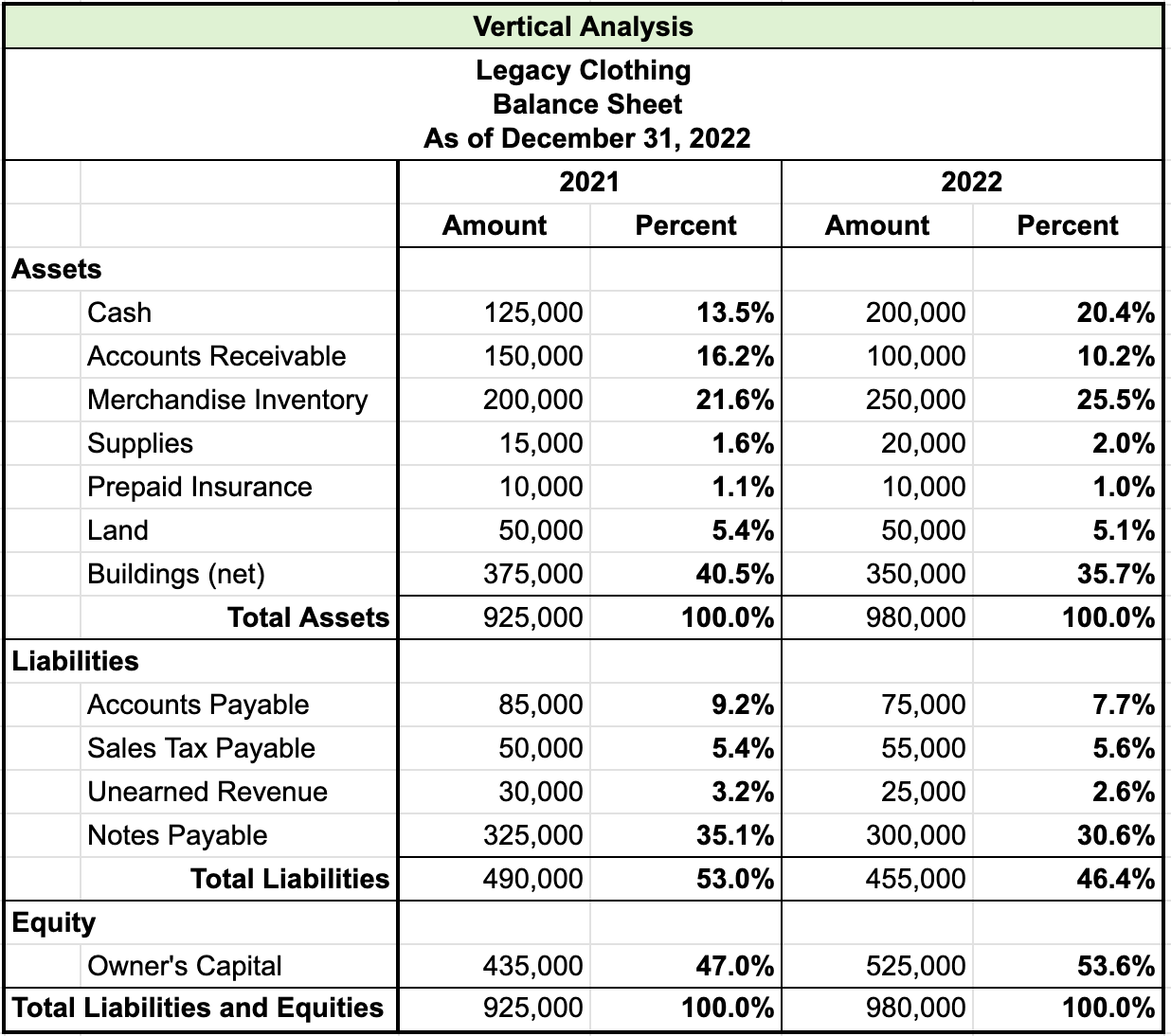
Now we're going to turn our attention to our horizontal analysis, which will help us understand trends in the individual financial statement line items and how they change over time.
Again, we're going to start with the income statement for our Legacy Clothing.
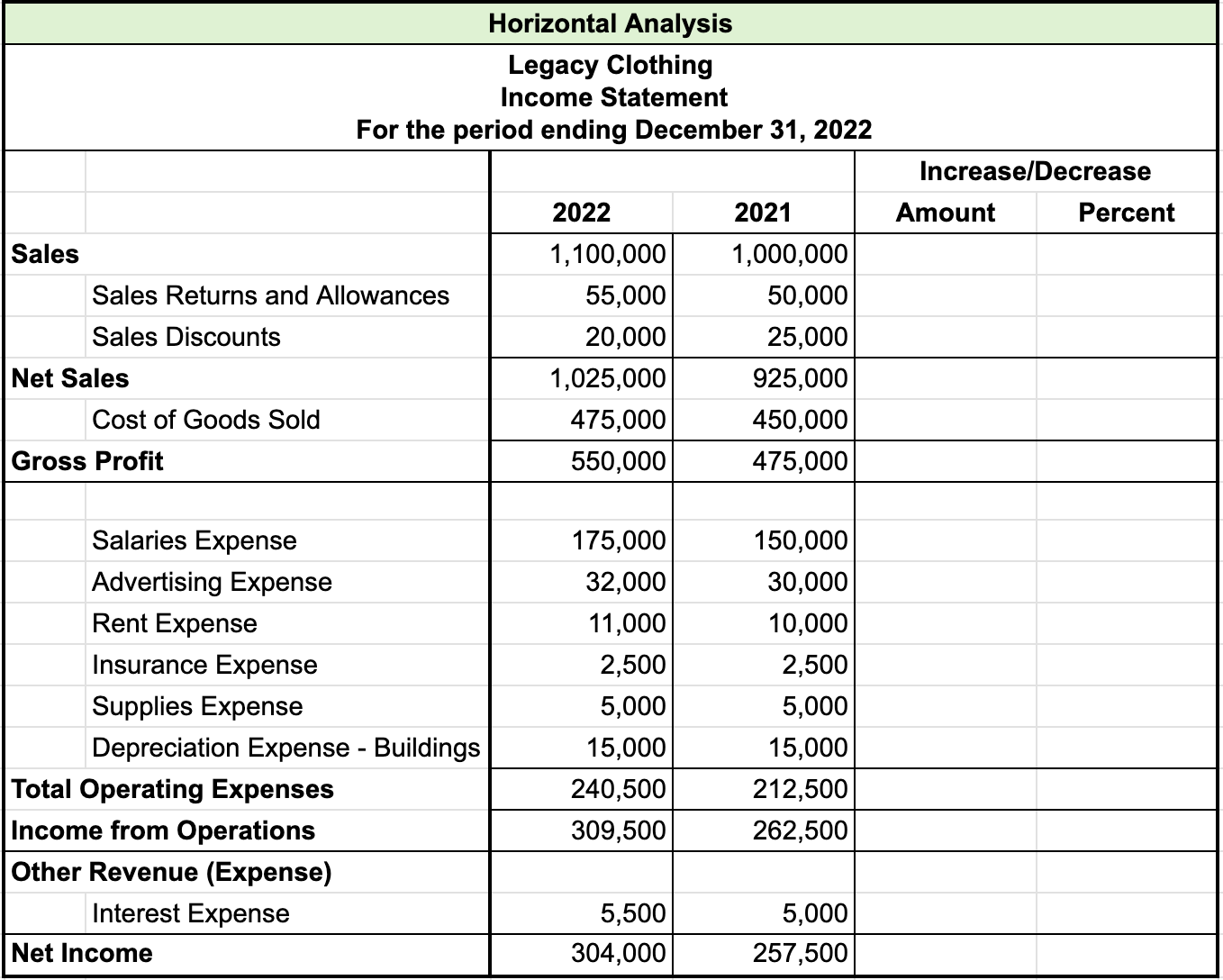
First, we express the changes from 2021 to 2022 in dollar amounts for each of these individual financial statement line items.
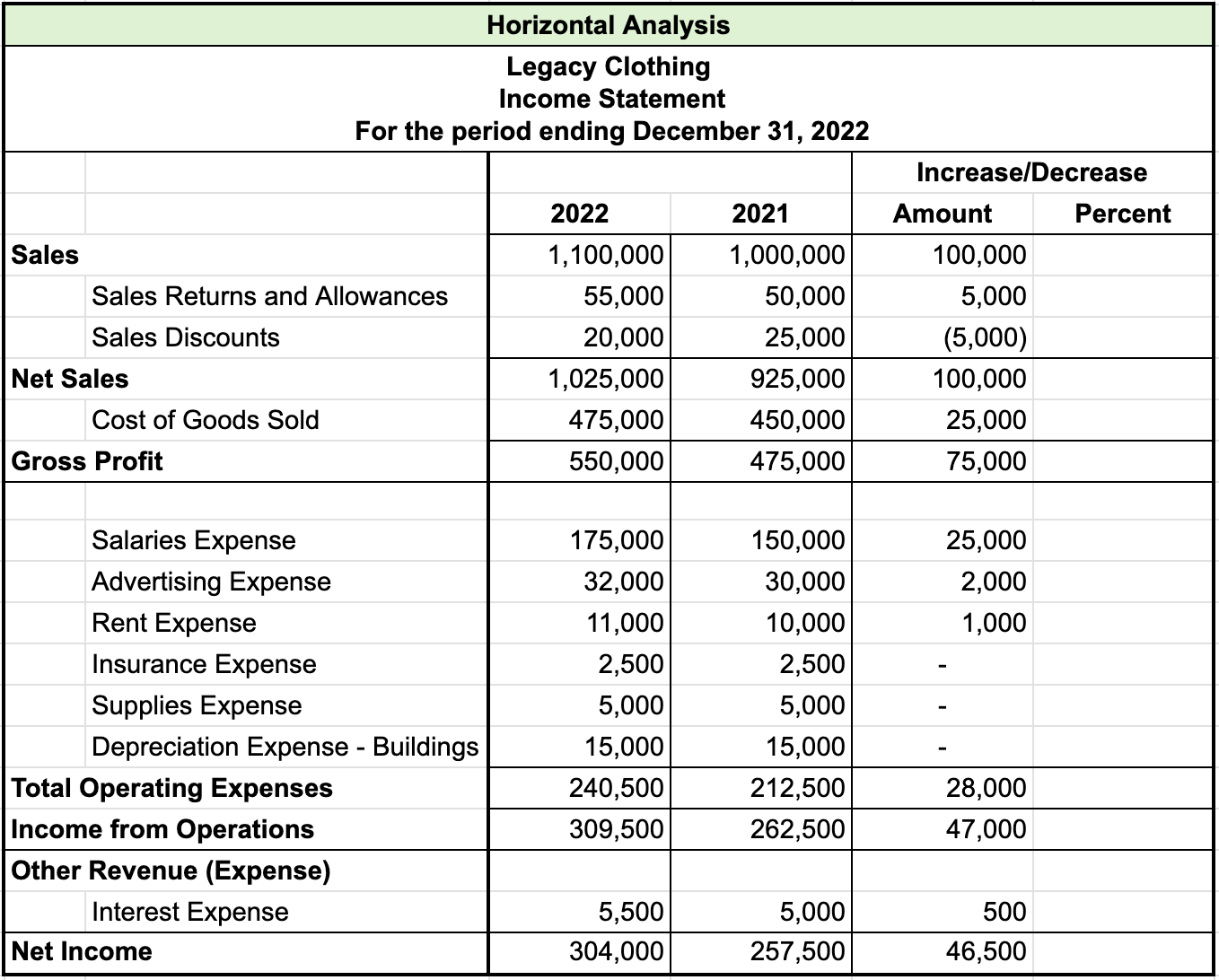
Now, once we have this information, we can convert those amounts to a percentage increase or decrease, so that we can understand how these individual lines are changing.
In this case, we can see that sales have increased by 10%, year over year. However, sales discounts actually decreased by 20%, which means we are issuing less discounts. Also, we can see that our salaries have increased 16.7% from 2021 to 2022.
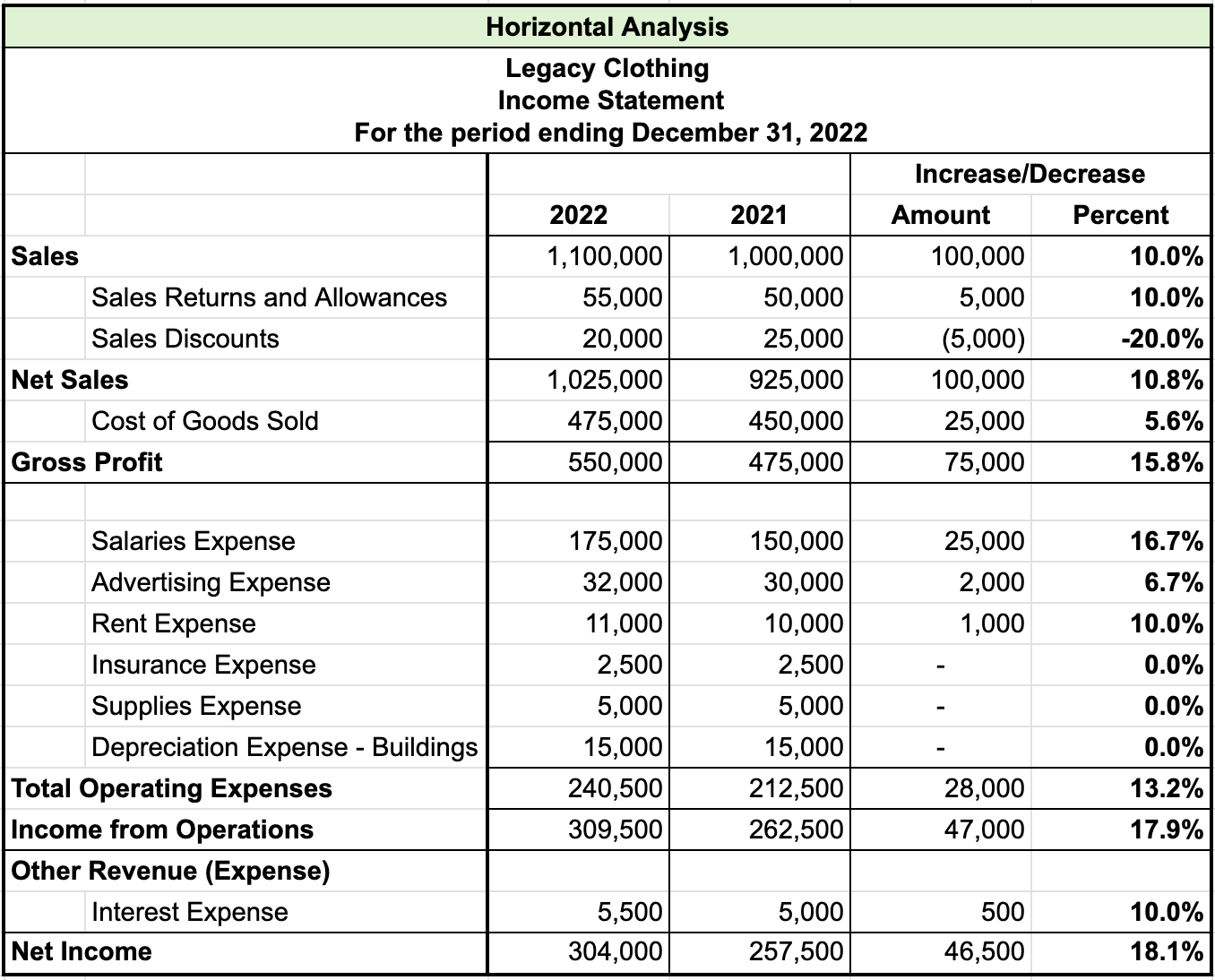
Next, Legacy Clothing will perform a horizontal analysis on its balance sheet.
Once again, we will evaluate the individual financial statement line items on the balance sheet to see how they have changed from one year to the next.

The first thing we do is to express that change in dollars, whether an increase or decrease, for each of these individual financial statement line items.
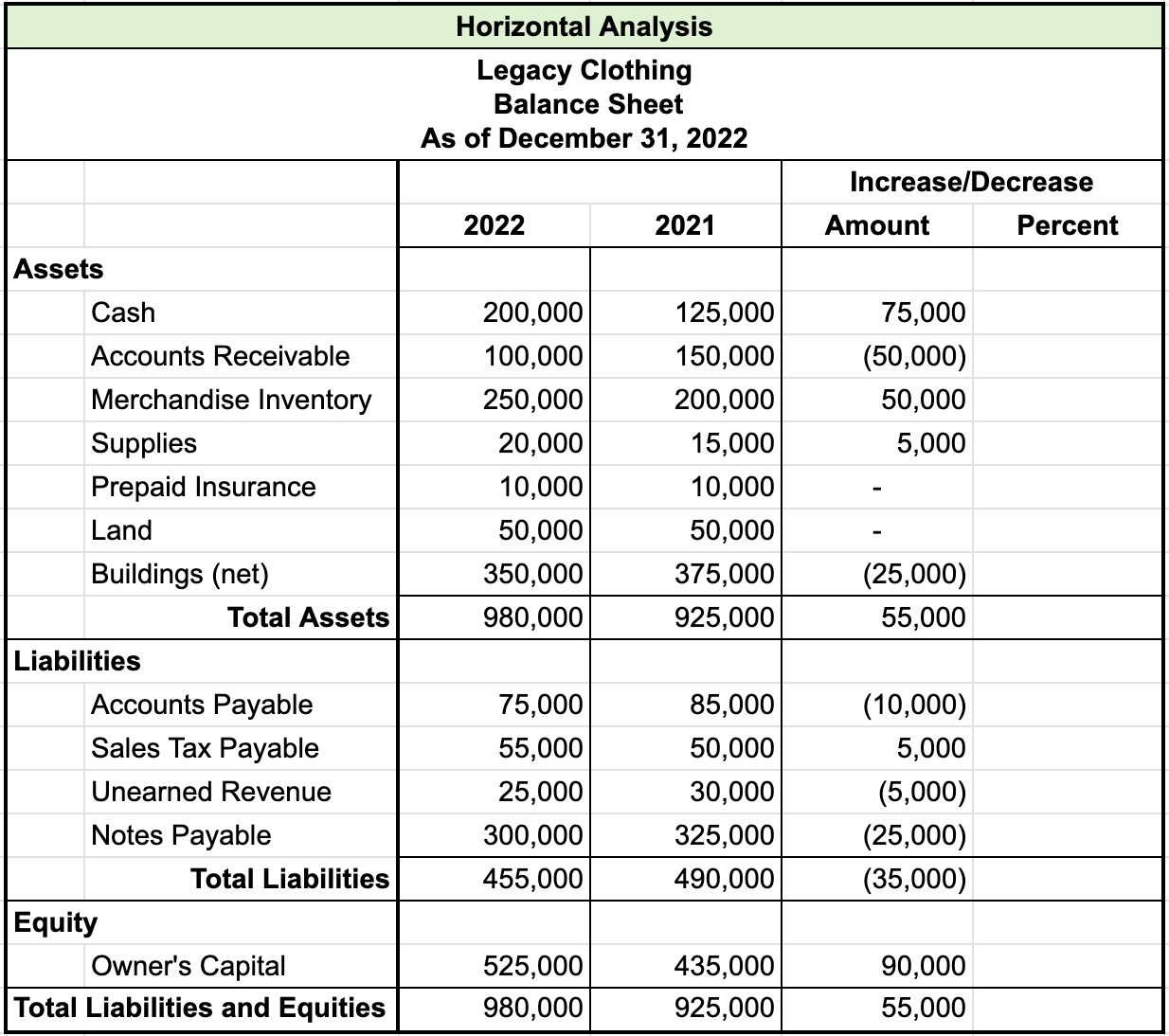
Next, we convert that dollar amount change to a percentage, to show us the percentage change of these individual financial statement line items. As you can see, cash increased by 60% and merchandise inventory increased 25%. However, accounts payable decreased by 11.8%, which tells us that we are paying down our short-term debt.
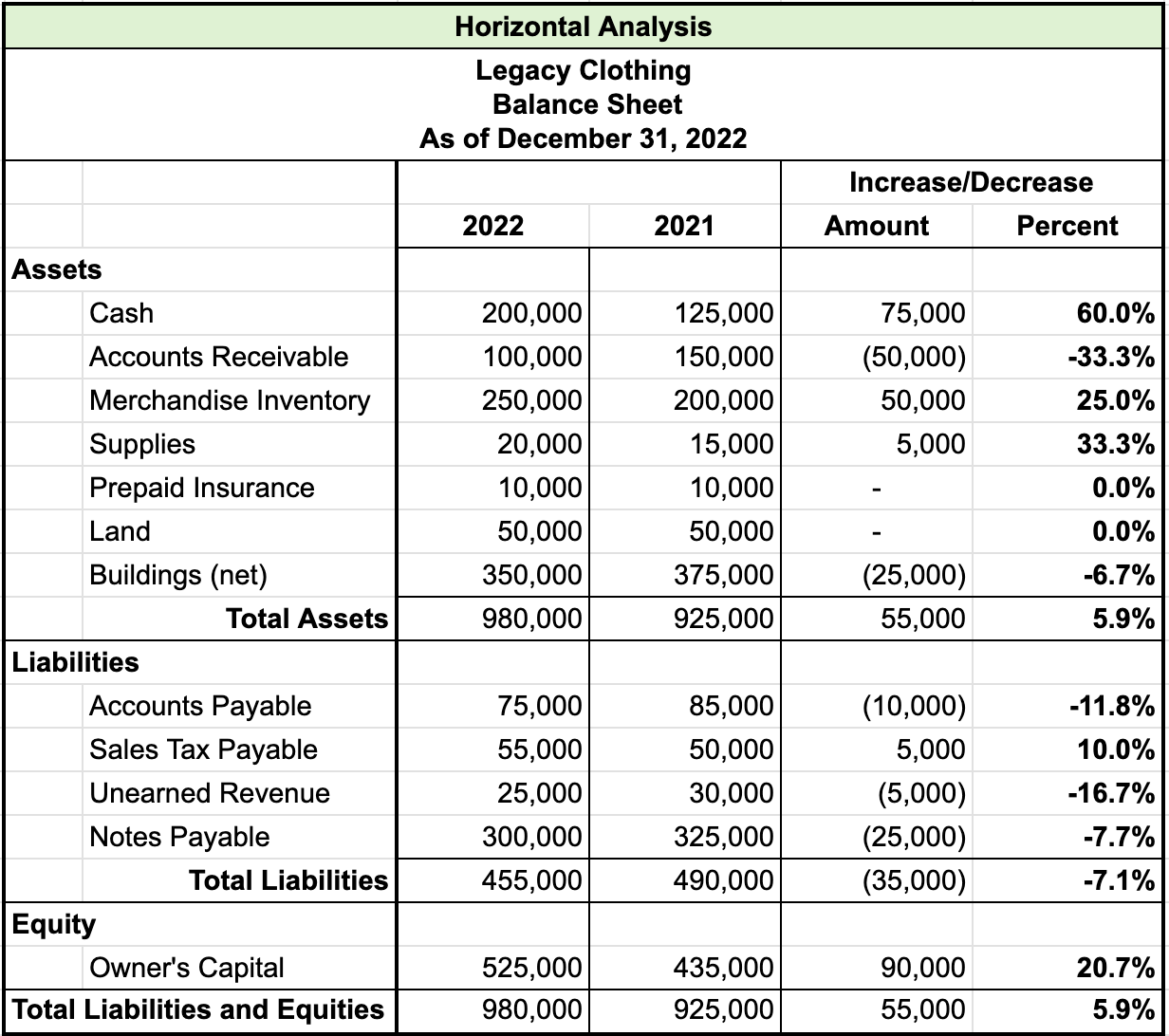
The last type of analysis that Legacy Clothing will perform today is ratio analysis.
Let's start with profitability ratios, which measure the operating performance of the company.
We will calculate three different profitability ratios: rate of return on sales, return on total assets, and asset turnover.
So, let's look at rate of return on sales, which is net income divided by net sales, and input our figures for Legacy Clothing from the income statement, where net income is $304,000 and net sales is $1,025,000. We can see that Legacy’s rate of return on sales is 29.7%. This means that 29.7% of every dollar Legacy generates in net sales, becomes its profit.


Return on total assets measures how effectively Legacy Clothing uses its assets, expressed as income before interest expense and taxes, divided by total assets. Plug in Legacy Clothing's information, which is $309,500 for income before interest and expense taxes from the income statement, and $980,000 for total assets from the balance sheet. The return on total assets for Legacy Clothing is 31.6%. A high asset turnover means a company is running efficiently, where a low asset turnover means there is room for improvement.


Asset turnover measures the use of assets to make sales, calculated by taking net sales divided by total assets. In this case, net sales is $1,025,000 from the income statement and total assets is $980,000 from the balance sheet. So the asset turnover is 1.0 times. Regarding the asset turnover ratio, the larger the better.


Finally, Legacy will look at its liquidity ratios. Liquidity ratios measure the ability of our company to pay their debts, when they are due.
Legacy will calculate both the current ratio as well as inventory turnover.
The current ratio shows how much in current assets we have to pay off our current liabilities, or short-term debt obligations. Plug in the information from Legacy Clothing, current assets divided by current liabilities. Looking at the balance sheet, we can see that current assets (cash, accounts receivable, merchandise inventory, supplies, and prepaid insurance) add to $580,000, while current liabilities (accounts payable, sales tax payable, and unearned revenue) add to $155,000. Using the formula, the current ratio is 3.74. As we can see, Legacy’s current assets far exceed its currently liabilities.


Inventory turnover tells us the number of times inventory is sold and replaced during the period, expressed as cost of goods sold divided by average inventory. The more times the inventory turns over, the more efficient the company is at managing its stock of goods. Legacy inputs the $475,000 for cost of goods sold from the income statement and $225,000 for average inventory from the balance sheet, to calculate its inventory turnover and finds it is 2.1 times.


Source: THIS TUTORIAL WAS AUTHORED BY EVAN MCLAUGHLIN FOR SOPHIA LEARNING. PLEASE SEE OUR TERMS OF USE.